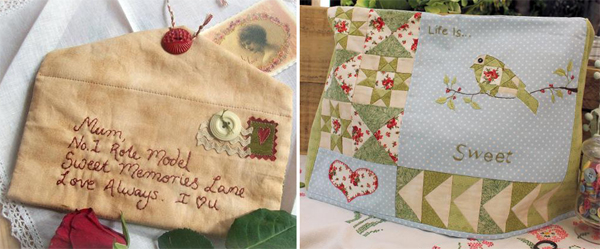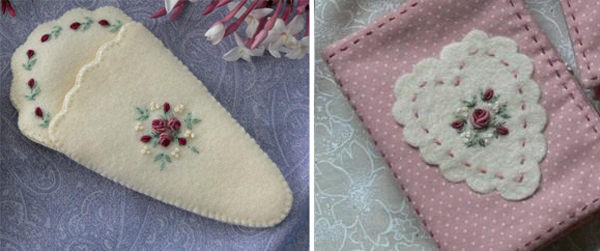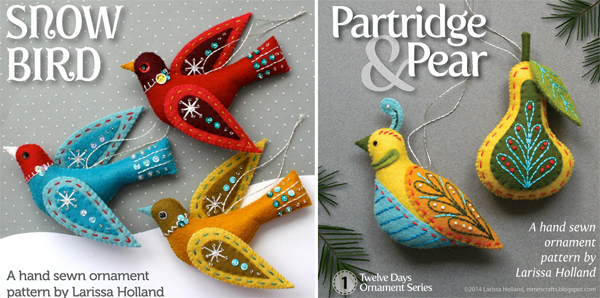There are so many different blends of fabrics on the market. Does it really matter which fabric type you embroider on? You bet it does! I’ll tell you why.

Thank You for the World so Sweet photo via Val Laird Designs
What are the best fabrics for embroidery?

Photos via Bella Bleu Michigan and Edies Designs.
Natural fabrics with a tight weave, like cotton, linen, silk and wool, are the best fabrics for machine and hand embroidery. Their construction ensures a sturdy surface that easily supports decorative stitching. Satin-stitched edging, typical in appliqué, needs a particularly strong foundation fabric.

Photos via Sanity’s Machine Embroidery Designs and Embroidery Super Deal
The ways in which natural fibers are woven are also helpful to embroiderers. Individual fibers run both horizontally and vertically, allowing needles to easily pass through them. With synthetic fabrics, embroidery needles often perforate threads that end up fraying over time.

Photos via SEW Useful Designs
Here are five of the best fabrics for embroidery:
Quilting cotton
Probably the most obvious choice for embroidery is 100 percent quilting cotton. Why the designation “quilting?” Quilting cottons are heavier than heirloom cottons like Nelona or Swiss Batiste. Heirloom cottons are also 100 percent cotton, but are sheer which is problematic for both hand and machine embroidery as threads often show through.

Photos via Marjorie Busby of b-quilts
With the crossover of embroidery and quilting, many quilters now incorporate hand and machine embroidery into their projects, so cotton fabrics are abundantly available.

Photo via Appliqué Geek
Heavyweight canvas cotton is known as utility cloth. That makes canvas the preferred fabric for embroidering on heavily used items like tote bags.

Photo via Machine Embroidered Lace Classics with Hope Yoder.
Linen
Linen is lighter, more textured, and 30 percent stronger than cotton. Created from the flax plant, linen is considered the strongest of natural fibers and wears extremely well. That’s probably why even the most used of antique linens are still highly sought after.
Silk

Photo via Embroider Luxury Fabrics by Machine with Pam Damour
You may think of silk as a delicate, flimsy fabric but that is not always the case. Silk dupioni combines the luxurious shine of silk with a crisp, strong base. Fine silk threads run vertically in the fabric, along the selvage. Silk from conjoined cocoons run horizontally in the fabric producing a textured effect.

Photos via Val Laird Designs
Wool
Whether it is pure wool, felted wool or even synthetic blends of wool felt, this fiber is particularly suited for embroidery. It is strong, does not fray in felt form, and provides some depth for embroidery without the nuisance of a deep nap that would swallow up stitches.

Photos via Larissa Holland of MMMCrafts
One of the biggest advantages of stitching on wool felt is the it does not produce a raw edge that needs to be finished or hemmed, making it perfect for decorative crafts.
Learn how to embellish wool in Craftsy’s class Stitch It With Wool: Crewel Embroidery with Kristin Nicholas.

Photos via Jenny of Elefantz
Blends
I asked Jenny of Elefantz what type of fabric she used in her numerous (gorgeous) hand-stitched designs. She said it is known as hanky linen in Australia, a rather deceptive term as the blend of 55 percent cotton and 45 percent linen is heavier than what you would think. Its beautiful texture makes the perfect backdrop for hand-dyed threads.

Nice read, I also like a wool/rayon mix, we purchase ours from the Felt Store.
Hello -- Could someone please elaborate on the section here about how to hand-embroider on silk? (What type of needle, will regular embroidery floss be used, and is dupioni the easiest or is there any other silk even easier to use as a fabric?) This would be for an embroidered panel that will be sewn onto a fine wool prayer shawl. Thank you!
I think I would like to try some linen. Have not done much embroidery, except what my mom taught me as a young girl. All I have embroidered are pillow cases, lol. But that was good to start out on.
good explanation liked the examples